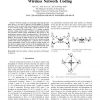Free Online Productivity Tools
i2Speak
i2Symbol
i2OCR
iTex2Img
iWeb2Print
iWeb2Shot
i2Type
iPdf2Split
iPdf2Merge
i2Bopomofo
i2Arabic
i2Style
i2Image
i2PDF
iLatex2Rtf
Sci2ools
TMC
2010
2010
On the Performance Bounds of Practical Wireless Network Coding
—Network coding is an attracting technology that has been shown to be able to improve the throughput of wireless networks. However, there still lacks fundamental understanding on how network coding works under realistic scenarios. In this paper, we examine the performance of a recently proposed network coding system under a realistic wireless physical layer and practical random access mechanisms. We propose a key performance measure called “encoding number”—the number of packets that can be encoded via network coding in each transmission. We provide an upper bound on the encoding number for the general coding topology, and derive the average encoding number and system throughput for a general class of random access mechanisms. Based on the practical coding system, we also derive a tighter upper bound on the throughput gain for a general wireless network. Our results are of fundamental value for coding-related MAC/Routing protocol design and analysis.
| Added | 31 Jan 2011 |
| Updated | 31 Jan 2011 |
| Type | Journal |
| Year | 2010 |
| Where | TMC |
| Authors | Jilin Le, John C. S. Lui, Dah-Ming Chiu |
Comments (0)

